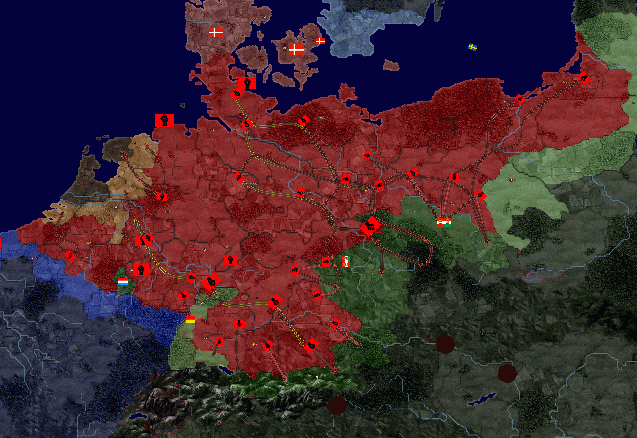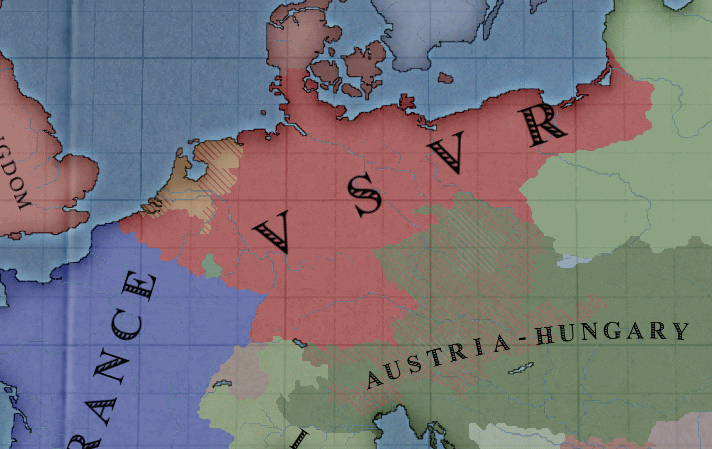The VSVR 1870-1875 (Part 2)

The Bohemian War was to be the first meaningful test of the progress of the Red Army since the Revolution and would be the first time since Kadon had taken over that it was to see active combat. Whilst Kadon held much less control over the military than Weydemeyer had he did introduce several key reforms. Firstly and most importantly he created the Red Guard – elite infantry units whose duty was not just to secure military victory but also to help the revolution progress. These men were instructed to spread the socialist ideology into foreign lands, help redistribute wealth in occupied territory and to direct worker and peasant anger against their masters. These men would leave a legacy long after leaving any territory. On top of this they were elite fighting units who would bolster the rank and file (Red Guards made up around 1/3 of the standing army). Kadon had also massively widened the conscription base and introduced a system to ready the tens of thousands of conscripts in quick time.
When war was declared the Red Army consisted of some 80 brigades – 200,000 men. This large standing army was to be bolstered by 220 brigades of conscripts – 880,000 men. This took the total mobilised force of the VSVR to an awe inspiring 1.08 million men with upwards of 100,000 Danes promised from the Republic’s European ally.
Dots mark location of Habsburg reserve armies
The battle plan was reasonably simple. In the West the Netherlands was to be overrun with conscripted troops whilst Baden was invaded by a few elite units. It was in the East where the war would be won and lost. In the Alpine portion of the front a large number of soldiers were to march into the fortified Alpine border between Bavaria and Austria to take the forts before Austria could bring troops to bear in that region, to the East of Munich further troops were to begin to march directly Eastward to threaten Vienna and prevent Austria from bringing its reserves to into action in the crucial Northern frontier. A huge invasion was to be launched into Bohemia to simply overwhelm the Austro-Hungarians and secure the vital territory. Finally and most importantly a large number of soldiers, a mixture of regulars and conscripts, were to launch an all out attack on the lynch pin province around Breslau. Protected on three sides by a river and acting as a bottleneck province that would prevent any invasion from directly to the North Breslau had been chosen as the focus for the Habsburg Army and the largest single army under Vienna’s command had been placed there. If the Habsburgs could be crushed at Breslau they could been defeated anywhere.
On all fronts the Red Army met with early successes as at Arnhem in the Netherlands the Dutch were swept aside by an army of men who had just weeks ago been working in factories and mines. In Baden superior quality, numbers and the support of the local populace meant the Badenese Army was swiftly forced to withdraw to the South-West whilst in both Bohemia and the Alpine front what little Austro-Hungarian resistance was met was simply brushed aside in the face of the revolutionary army.
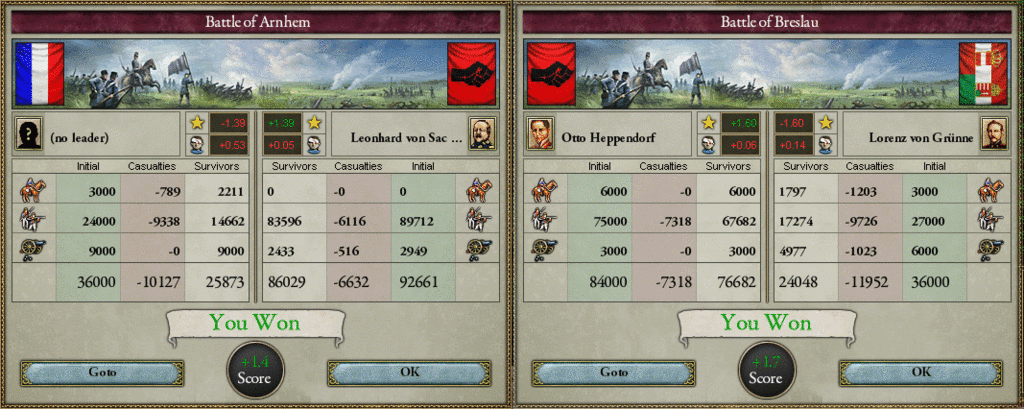
However Breslau was a much bloodier affair. The initial assault by professional troops on the Habsburg defensive positions was battered back with heavy causalities suffered by the Red Army. This enticed the Austrians into counter-attacking just as thousands of conscripts arrived from the North. Now horrifically outnumbered and away from their defences the Habsburg units faced and utter mauling and lost 1/3 of their men. They subsequently limped back into Moravia and Southern Silesia, praying for salvation from the Austro-Hungarian reserve and the arrival of the Turkish Army.
With these early successes the confident politicians in Cologne announced to the public that on top of Bohemia they would also secure Silesia’s freedom for the revolution. The response to this was typically riotous and thousands rushed to volunteer to fight for the revolution and thousands more promised to do what they could for the troops.
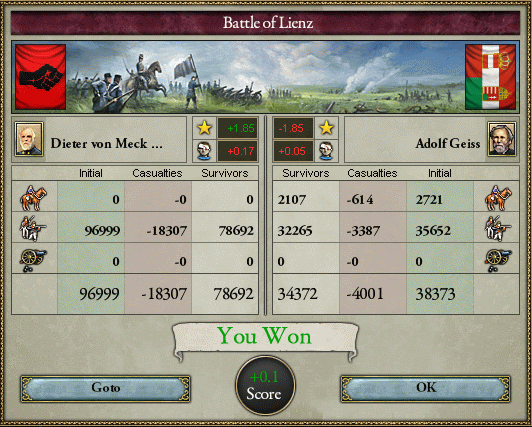
Yet after these great victories of June the Republic was given a harsh reminder of its limitations in July at the Battle of Lienz. He a massive army of conscripted Bavarian soldiers redefined the meaning of a Pyrrhic victory. Just to the South of the main line of forts an army of Habsburg professional soldiers bolstered by some Italian conscripts established a defensive position in the mountainous passes. The local Red Army commanders believed they could simply bludgeon their way through this road block and in many ways they were proved right. After committing almost 100,000 men to the battle against an army 1/3 of that size and losing 4 and ½ times as many men as the enemy, the Austrians were forced to withdraw from Lienz. However Habsburg Italy was saved from the immediate threat of invasion as the Red Army licked its wounds from this defeat.

However just two days after the tremendous slaughter of Lienz had drawn to an end the Habsburgs faced a reverse which effectively ended their hopes of continuing to fight on in Bohemia as 15,000 men surrendered at Krems. It was one of the worst military embarrassments the Habsburgs had ever faced, to make matters worse the army was largely Czech and many of its men chose to join the fight on the side of the VSVR.
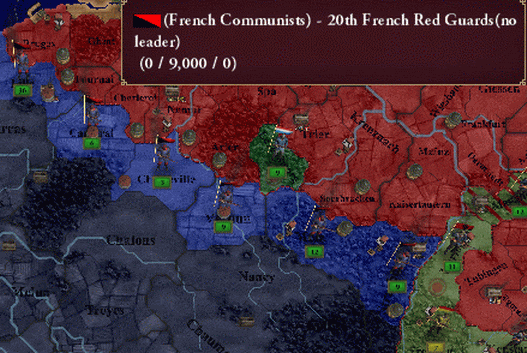
In this atmosphere of revolutionary fervour that swept the VSVR it was easy for the enthusiasm to spread. Many were calling this the final conflict of human history (although the VSVR leadership had no intention of making it so) and across the world thousands rose up. However most rebellions were minor affairs with the exception of what happened in France where tens of thousands of communists of all varieties rose up against their masters in France. With Northern France being the main base for the revolution Catalonia was another significant focus of the French rebellion and here socialism was mixed with demands for reunification with Spain and even independence. As the French army initially struggled against the revolutionaries in July Spain invaded Catalonia in mid August in hopes of reclaiming the lost territory.
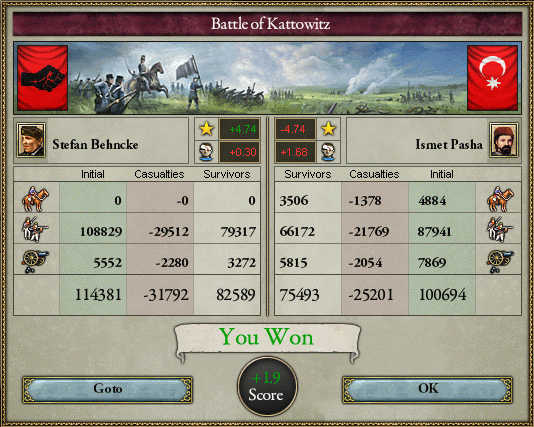
With France in chaos August and September witnessed the bloodiest conflict of the entire war at Kattowitz in Southern Silesia. Here an army of around 100,000 Turks and Austro-Hungarian soldiers did battle with 114,000 Red Army soldiers. In the resulting slaughter around ¼ of the combatants were killed and looking at the casualties there was no real decisive winner. However this is deceptive as the battle effectively ended all hope of a turnaround for the Habsburgs. By this stage they had been crushed on all other fronts, Vienna was under siege and Bohemia overrun, at Kattowitz the last force that could realistically address the collapse of the Eastern Front was defeated and forced to withdraw. The Habsburg Empire no longer had anything that could stop the Red Army.

After initially looking unsteady the French Army rebounded strongly following the arrival of reinforcements from North Africa. The Spanish were forced back from Barcelona in Catalonia and left in a standoff with French troops across the front. More importantly the revolutionaries were crushed across the country. The last great communist army (around 40,000 men) was defeated by General Duchene’s army of a similar size at the Battle of Lille on September 26th. With its house back in order a wave of reaction swept across the French government and Duchene was ordered to advance into the VSVR, to crush the force that so long as it existed would bring wave after wave of civil war to the French nation. Duchene marched just a few miles over the border to the fortified town of Tournai where he met some ragtag Republican resistance. However this resistance was enough to delay Duchene long enough for reinforcements to arrive. For the next two months Tournai would receive a steady stream of reinforcements from the Netherlands and from Austria as the tide steadily turned against the French.
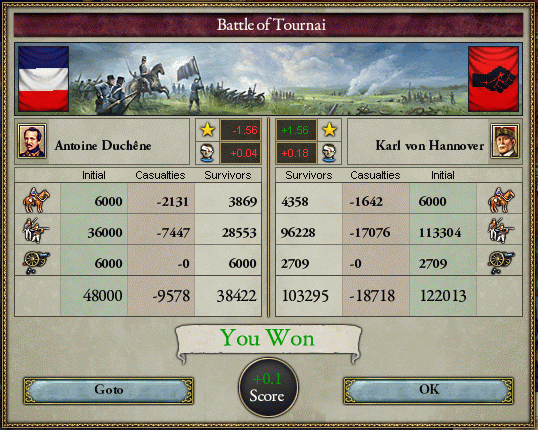
For the first time in the war the Red Army had met a force that was just as well equipped and even better trained than it. However, despite heavy losses, it had won. Duchene’s army represented the only military force the French could muster on their Northern border, following Tournai both armies simply sat on their own side of the border and waited for the other to strike – which they never did.
Following the old adage that the enemy of my enemy is my friend the VSVR sent support to the Kingdom of Spain – however the specialists sent to Iberia would do as much to undermine the government as support it as they helped rapidly spread the socialist message amongst the people.
The war would drag on until February 1874. Following the fall of Vienna the Habsburg government had fled first to Budapest and then later to Cluj. However the Hungarian Parliament had stayed put. After an extended period under siege Hungarian Parliament in Budapest managed to send a message to Cluj – either you make peace now or we leave the war on our own. Essentially ½ of the Empire had threatened to exit the war whilst the half that was willing to continue (banking on a French offensive) was largely occupied.
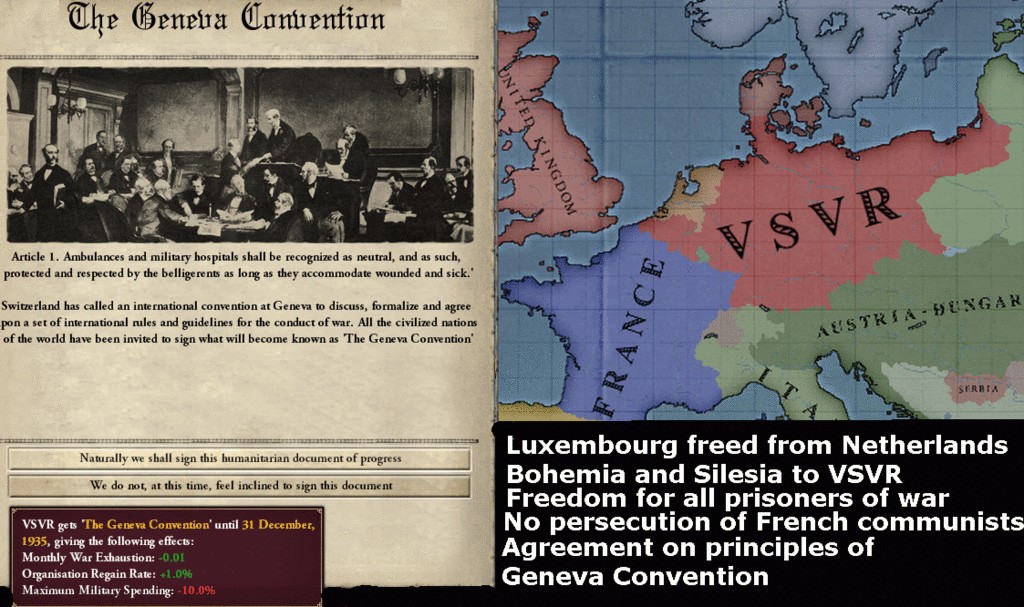
On February 7th French, Spanish, Austro-Hungarian, Ottoman, Dutch, VSVR and British (as arbitrators) delegates met in Geneva to agree to a peace treaty. The VSVR refused to even discuss Baden (which had been annexed in October) but for the most part agreements were made amicably. The Dutch were forced to forever cut off ties with Luxembourg in a move that benefitted France as much as the VSVR; the Habsburgs were forced to cede the heart of their industrial sector as they handed Bohemia and Silesia over. All prisoners of war were set free – this was most beneficial to Austria-Hungary which had tens of thousands of men under Republican captivity. Perhaps most importantly of all the present countries all agreed to the Geneva Convention which set out several rules for the humane guidelines under which all future wars were to be fought. The war was a stunning success for the Republic; the Red Army had defeat not one but three great powers at once. The VSVR was now considered to be the second most powerful state on earth behind only the British Empire.
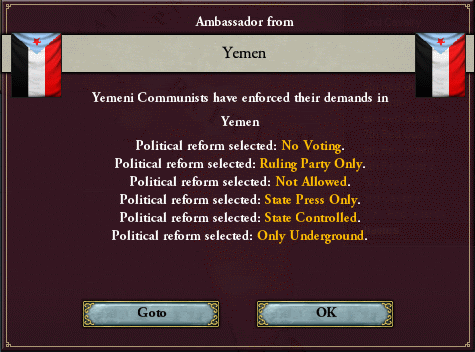
But the good news did not end there for the Republic. Following the Bohemian War there was an upsurge in revolutionary enthusiasm as socialists the world over felt that anything was possible. Incredibly this led to the victory of the Communists in deeply Muslim Yemen. Yemen was a nation of some 400,000 people and bordered the Hedjaz which contained Mecca itself. A Leninist style coup allowed the Communists to secure power despite being a rather minor faction within Yemeni politics. However as soon as support started to arrive from the VSVR their position was solidified. Despite being economically barren Yemen provided the Comintern with a lot of strategic usefulness. Here they had a jump off point from which the revolution could be spread to the entire Muslim world and to the Indian Ocean.
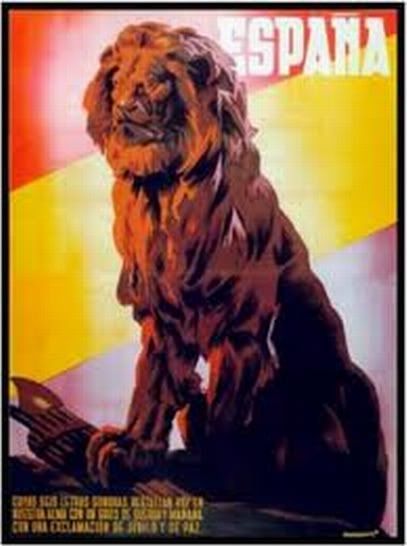
The Kingdom of Spain would never recover from the Bohemian War. Its army had been badly led and crushed during the conflict in Catalonia whilst ineffectual offensives in the Pyrenees had caused a deep loathing of the hierarchy by the common soldiers and people of Spain. On top of this interaction with the VSVR and with the Catalonians rebels (many of whom later fought alongside the Spanish Army) brought socialism to Spain on a much larger scale than the state had ever before experienced. Following months of anger at the state Spain erupted into rioting in October and on November 9th the Army marched into Madrid, overthrew King Amadeo I (a much maligned Italian) and his regime. Unlike most Communist revolutions this one did not end in a regicide but instead Amadeo wilfully surrendered his thrown in return for a few concessions – he, his family and all his supporters were granted free passage out of Spain; he was to be allowed to take exactly ½ of his wealth with him out of the country (the rest was to be seized by the new regime); the churches would be protected from the destruction they faced in the VSVR and Denmark and finally the new Republic would promise to do all it could to one day reclaim Catalonia. These terms were eagerly agreed to. Spain was quickly rushed into the Comintern; however it has the simple problem of a large Empire to deal with. Pablo Iglesias arrived from Cologne with a solution.
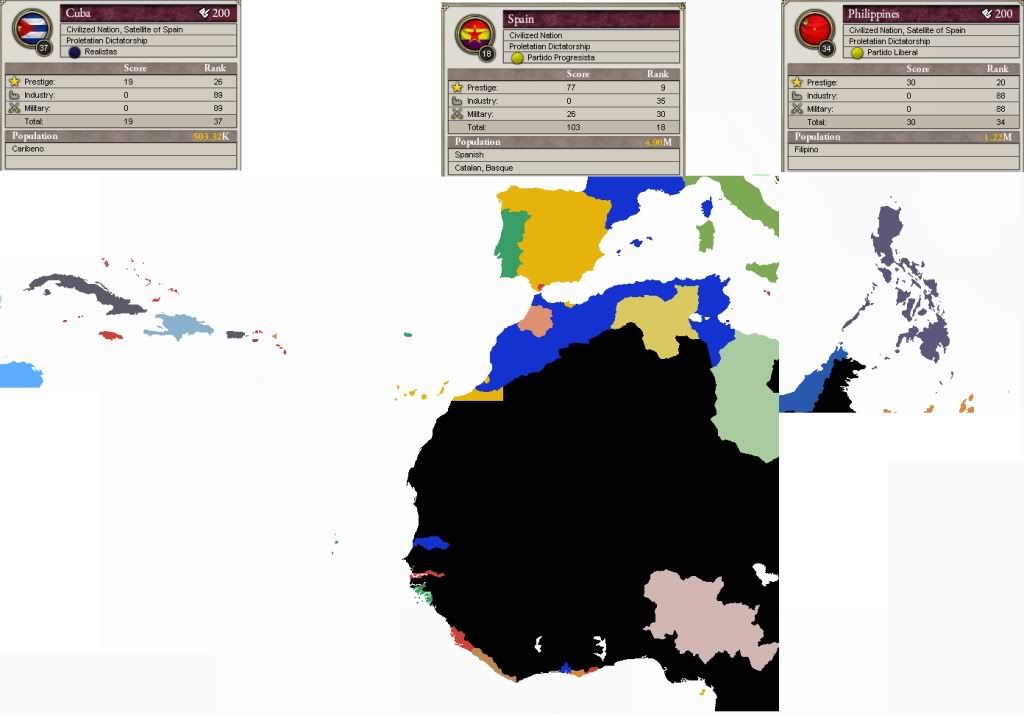
The Spanish Empire was divided into three parts. The lands West of the Atlantic became the Republic of Cuba and consisted of the former Spanish colonies in the West Indies (notably the islands of Cuba and Puerto Rico). This Republic had around 2 million citizens. The Asian portion of the Empire, the Philippine Islands, became the Republic of the Philippines. This portion of former Empire had nearly 5 million people and was divided between the Spanish speaking portion of the population (60%) and the population which continued to speak native languages. Finally The Spanish Republic consisted of the territory in Iberia and in Africa with the Canaries, a few enclave ports in Morocco and the island of Sao Tome in the Bight of Benin. This final portion of had nearly 20 million people and was by far the wealthiest part of old Empire. Spain retained some economic control in Cuba and the Philippines but most importantly of all it retained military bases in both territories (at the request of the governments of the two island chains). In Cuba there was to be a permanent Spanish base at Guantanamo Bay in southern Cuba whilst in the Philippines Spain retained bases near Manila on Luzon and Davao on Mindanao.
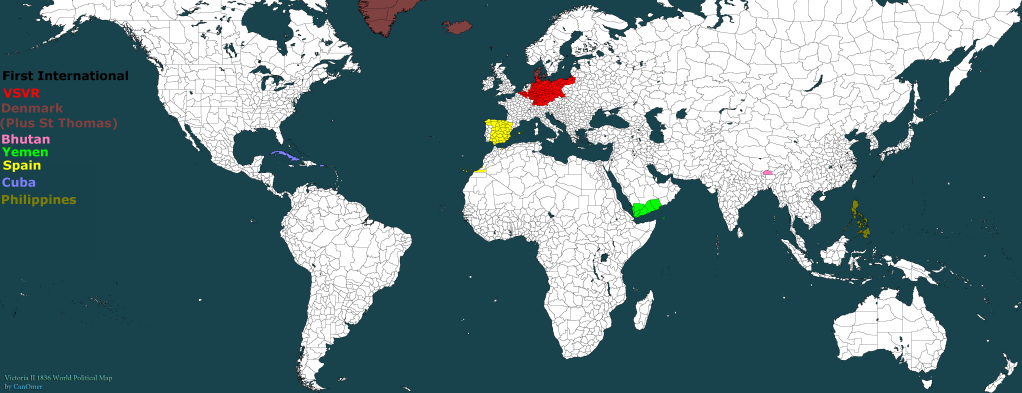
The Comintern now held sway over a substantial portion of the world. With well over 100 million people (the vast majority of them in the VSVR) living under a Communist government there were now more people in the Comintern than in the Russian Empire.
Back to the VSVR, the war had been a major boon for the VSVR arms and shipbuilding industries and had contributed to a spike in industrial growth. Overall the VSVR’s industrial sector had grown by a further 120% during Engels’ second term. The VSVR had left France in its wake and had overtaken Russia, it now had an industrial sector about 2/3s the size of Britain’s. However the short term boost of war failed to hide the systemic problems of overproduction which blighted the Republic’s industry.
 Finally - I wanted to post some Utah Phillips, but can't find the song/spoke word I'm looking for. Sigh.
Finally - I wanted to post some Utah Phillips, but can't find the song/spoke word I'm looking for. Sigh.



